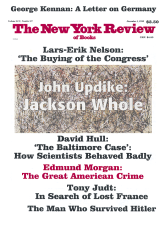In response to:
The New New Math from the September 24, 1998 issue
To the Editors:
There are many aspects of Martin Gardner’s critique [NYR, September 24] of the current reform movement in mathematics education that invite rebuttal. In this communication I would like to take up his treatment of the Pythagorean theorem.
Gardner objects to having students discover this important mathematical principle through the use of “manipulatives.” He describes a game in which students “cut from graph paper squares with sides ranging from two to fifteen units…. Using the edges of the squares, they form triangles of various shapes.” The “winner,” he says, “is the first to discover that if the area of one square exactly equals the combined areas of the other two squares, the triangle must have a right angle with the largest square on its hypotenuse…. ‘Constructivism’ is the term for this kind of learning. It may take a group several days to ‘construct’ the Pythagorean theorem. Even worse, the paper game may bore a group of students more than hearing a good teacher explain the theorem on the blackboard.”
I teach a college-level geometry course for future elementary teachers in which we spend several days studying the Pythagorean theorem and analyzing a few of the four hundred known proofs of this important proposition. At the end of this experience, I ask students to write in their journals about any new insights they have obtained from this reexamination of the Pythagorean theorem.
More often than not, students write something along these lines. “I always knew that the Pythagorean theorem was expressed by the formula a2 + b2 = c2, but I was surprised to learn that the theorem actually describes a relationship among areas of squares.”
Why is it that these college students find the connection between the Pythagorean theorem and the areas of squares such a revelation? From my experience most high school geometry textbooks prove the theorem using properties of similar right triangles. While this is one of the shorter proofs, it obscures the fact that the terms in the formula a2 + b2 = c2 represent areas of actual squares. Too often students simply memorize the formula without any real understanding of what a, b, and c stand for.
I wish our students would come to the university having learned the Pythagorean theorem through the method that Gardner ridicules. The activity he describes gives students the opportunity to work together and look for patterns. In the process they may discover more than just the Pythagorean theorem. They should also observe that in obtuse triangles the square of the longest side is greater than, and in acute triangles it is less than, the sum of the squares of the other two sides. They should also observe or rediscover that the sum of the lengths of any two sides must be greater than the length of the third side.
These discoveries, however, cannot be left to chance, but are more likely to take place under the guidance of a teacher. Contrary to Gardner’s assertion, cooperative learning does not imply that children receive “no help” from the teacher, nor that there are “winners” who discover what they are supposed to and “losers” who don’t. A skilled teacher guides the entire class in a discussion of what they have observed and in formulating the appropriate generalizations. Gardner is correct to observe that some students will become bored if the “exploration” phase is prolonged just as many students have been bored by brilliant lectures delivered by “good teachers.” The art of teaching involves determining an appropriate mixture of teacher-led and student-directed investigation and in determining when to intervene in cooperative group discussions.
Contrary to its most vocal critics, the mathematics education reformers do not advocate that teachers abdicate their roles as leaders in the classroom, nor that we abandon precision and rigor. It is ironic that Gardner accuses the reform movement of promoting “fuzzy” math, when traditional methods of teaching seem to result in so much fuzzy understanding among our students.
Timothy V. Craine
Associate Professor
Department of Mathematical Sciences
Central Connecticut State University
New Britain, Connecticut
Martin Gardner replies:
I am even more astounded than Mr. Craine to learn that college students in a math class would not know that the Pythagorean theorem is about geometrical squares. Surely this testifies to the miserable quality of pre-college math teaching.
The question is how best to teach this theorem to children in lower grades. Class time is precious. I cannot believe that a group of youngsters, struggling for days to invent the Pythagorean theorem by manipulating paper cutouts, will remember the theorem any better than hearing a good teacher explain it on a blackboard.
The University of Indiana’s mathematician/ logician Raymond Smullyan once taught high school geometry. He would chalk a right triangle on the blackboard and its three squares. Assuming the squares are made from sheets of gold, he would then ask his students which would they rather have: the large gold square or the two smaller squares. His students would be flabbergasted when told it made no difference because regardless of the right triangle’s shape the big square’s area always equals the total area of the two smaller ones.
I think this demonstration of the theorem would become more firmly fixed in a child’s mind than spending days in a group trying (perhaps unsuccessfully) to discover the theorem by themselves. Moreover, it allows the teacher time to explain how the theorem applies to semicircles and other similar shapes erected on the triangle’s sides, and other fascinating related facts. As a homework assignment, students could be asked to search for one of the hundreds of proofs mentioned by Craine. Unfortunately, fuzzy math educators are not much interested in formal proofs.
This Issue
December 3, 1998



